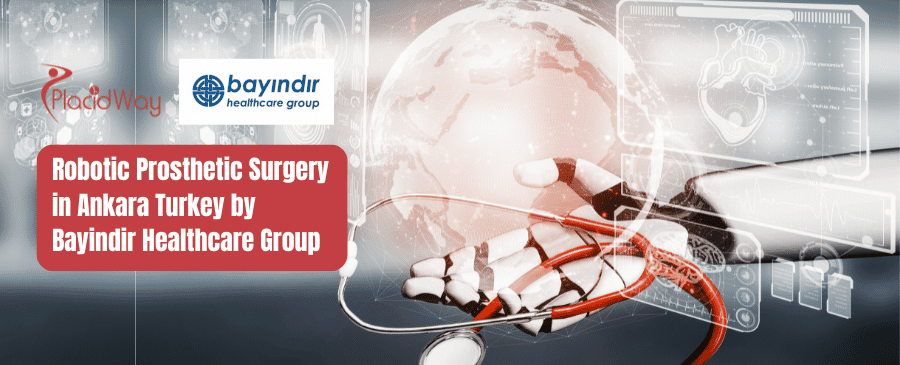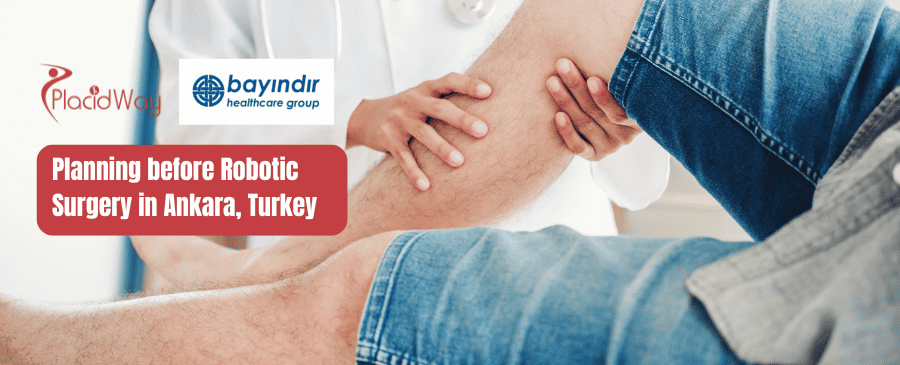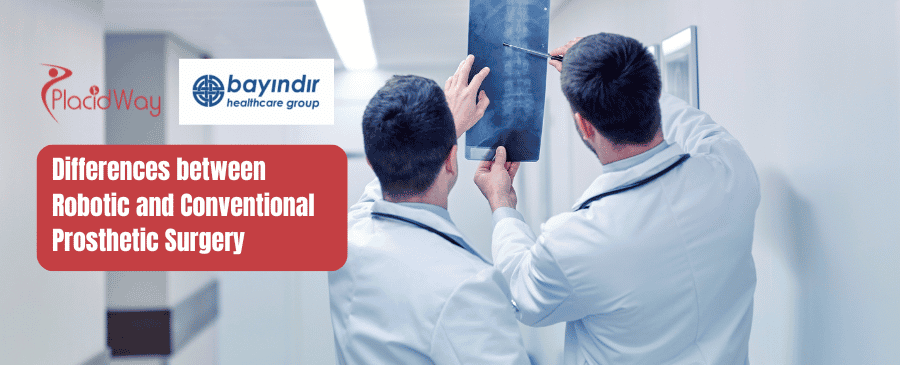
Robotic prosthetic surgery refers to the use of robotic technology in orthopedic procedures, particularly in hip and knee joint replacement surgeries. As technology advances, robots are increasingly being utilized in various fields, including healthcare. In orthopedics, robotic technology has found its place, and the number of orthopedic surgeries performed with robotic assistance is growing, such as in Bayindir Healthcare Group.
Applications of Robotic Prosthetic Surgery in Ankara, Turkey
Robotic prosthetic surgery is commonly used in the following conditions:
Hip and Knee Joint Prosthetic Surgery: The primary application is in the replacement of hip and knee joints with prosthetics. In the near future, it is expected to be used in shoulder, spine, and tumor surgeries as well.
Stages of Robotic Prosthetic Surgery
The key stages of robotic prosthetic surgery in Ankara, Turkey include:
-
Preoperative Planning: Patient-specific data, obtained through CT scans of both legs, is used to create a 3D model. The surgical plan, including bone cuts and prosthetic size and placement, is developed using specialized software. The orthopedic surgeon reviews and finalizes the plan.
-
Surgical Procedure: The surgery is performed using robotic systems under the guidance of an orthopedic specialist.
-
Bone Cut Planning: The cuts in the bone are planned in a computerized environment, ensuring precise positioning of components. These cuts are then executed with the assistance of a robotic arm.
Planning before Robotic Surgery in Ankara, Turkey

For robotic knee or hip surgery, CT scans of both legs (including the pelvic bone for hip prostheses) are taken. A 3D model of the leg is created using specialized software, allowing for the planning of bone cuts, prosthetic size, and placement. After the orthopedic specialist's final review, the plan is loaded into the robot.
Robotic Knee Surgery Procedure
-
Joint Access: The surgical area is covered to prevent water ingress. The robot is prepared with suitable sterile covers.
-
Electronic Eyes Installation: Electronic eyes are placed around the knee for the robot to recognize the bones. This provides information to the surgeon about bone cuts and ligament balance during the operation.
-
Point Mapping: The robot identifies 64 different points on the femur and tibia to acquaint itself with the knee joint.
-
Bone Cuts: The robot-assisted arm is used to perform precise bone cuts, ensuring a deviation within 1 millimeter and 1 degree. The surgeon monitors the entire process on a screen, and the robot halts if there's a tendency to deviate from the plan.
-
Trial Prostheses: After appropriate bone cuts, temporary prostheses are used to assess joint movement, ligament balance, and patellar movement. Adjustments are made if necessary.
-
Final Prosthesis Placement: Once the final decision on prostheses is made, they are cemented into place. The robot ensures balance and movement before completion.
Robotic Hip Prosthetic Surgery Procedure in Ankara, Turkey
-
Joint Access and Electronic Eyes Installation: Similar to knee surgery, electronic eyes are placed on the pelvic and femur bones for the robot to recognize.
-
Point Mapping: Over 50 points on the hip joint are introduced to the robot, providing 3D information.
-
Length Discrepancy Calculation: The robot calculates millimetric length differences between the legs.
-
Osteotomy and Prosthesis Placement: The femur head is removed, and appropriate-sized hollow reamers are placed. Trial prostheses are used to assess joint movement before placing the final prosthesis.
Patient Suitability for Robotic Prosthetic Surgery
Every patient undergoing joint replacement planning is a potential candidate for robotic surgery in Ankara, Turkey, given their general health status. Even patients with congenital hip dislocations can undergo robotic surgery with suitable planning. However, cases with advanced bone loss in knee problems may not be suitable for robotic prosthetic surgery. Additionally, robotic technology is not being used yet in revision surgeries for knee and hip prosthetics.
Duration of Robotic Prosthetic Surgery
The preparations for robotic surgery are more comprehensive than standard prosthetic surgery, adding approximately 15-30 minutes to the operating room time. As a result, the surgery duration is extended by about 15-30 minutes, in total approximately 1.5 hours for knee prostheses and 1.5-2 hours for hip prostheses.

Differences between Robotic and Conventional Prosthetic Surgery
While the fundamental procedure remains the same in both robotic and conventional prosthetic surgery, there are key differences:
-
Preoperative Planning: Robotic surgery requires CT scans and 3D modeling for precise planning, while conventional surgery relies on standard radiographs.
-
Precision during Surgery: Robotic surgery offers a high degree of precision, with cuts made within 1 degree and 1 millimeter accuracy, surpassing what can be achieved manually.
Advantages of Robotic Prosthetic Surgery in Ankara, Turkey
The advantages of robotic prosthetic surgery include,
-
Ideal Prosthetic Placement: Robotic assistance ensures optimal prosthetic positioning, leading to extended prosthesis lifespan and increased patient satisfaction.
-
Reduced Postoperative Pain: Patients typically experience less postoperative pain.
-
Shortened Hospital Stay: The time spent in the hospital is reduced.
-
Quick Recovery: Patients experience a faster recovery period.
-
Natural Feeling: The prosthetic joint feels more natural, and patients regain confidence in their movements.
-
Extended Prosthesis Lifespan: Due to precise placement, prostheses have a longer lifespan.
-
Improved Mobility: Patients experience increased mobility.
Postoperative Care for Robotic Prosthetic Surgery in Ankara, Turkey
After the surgery, patients typically stay in the hospital for around 3 days. They are prescribed pain relievers, stomach protectors, and blood thinners. Blood thinners are usually continued for about 30 days to minimize the risk of blood clot formation. Postoperative wound care involves using water-resistant dressings, and stitches are removed after approximately 15 days.
Patients are advised to use a walker until muscle control and self-confidence are restored. Following the recommended home exercises is crucial for a successful recovery.
In summary, robotic prosthetic surgery offers several advantages over conventional methods, providing precise planning, optimal prosthetic placement, and faster recovery for patients undergoing hip and knee joint replacement surgeries.
Get FREE QUOTE for Robotic Prosthetic Surgery in Ankara, Turkey at PlacidWay!
Are you considering robotic prosthetic surgery? Look no further! PlacidWay offers a hassle-free experience to get your free quote for robotic prosthetic surgery in Ankara, Turkey. Our state-of-the-art facilities and expert medical professionals ensure that you receive the highest quality care possible. Contact us today to begin your journey towards a better quality of life with our innovative robotic prosthetic surgery solutions.





-Treatment-Package-in-Izmir,-Turkey.png)











Share this listing